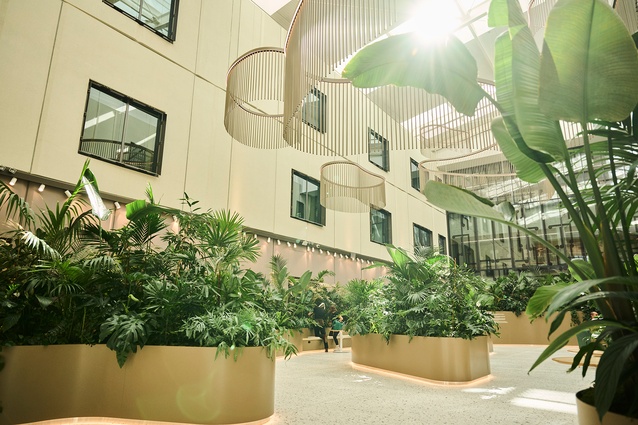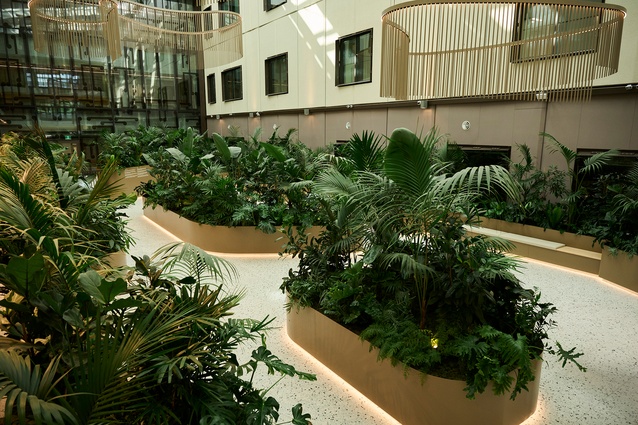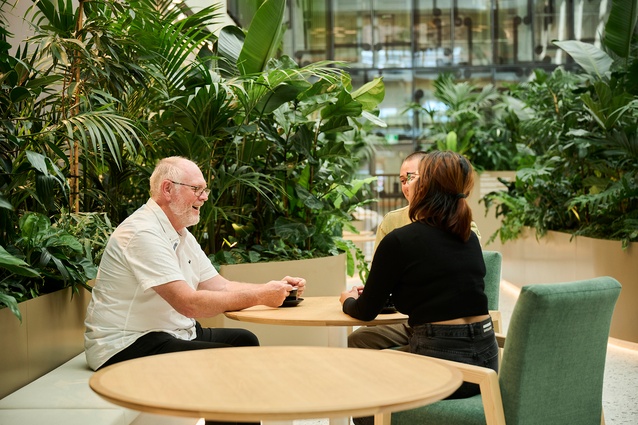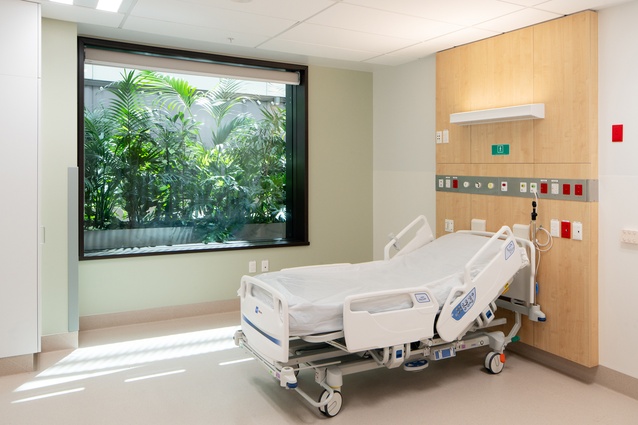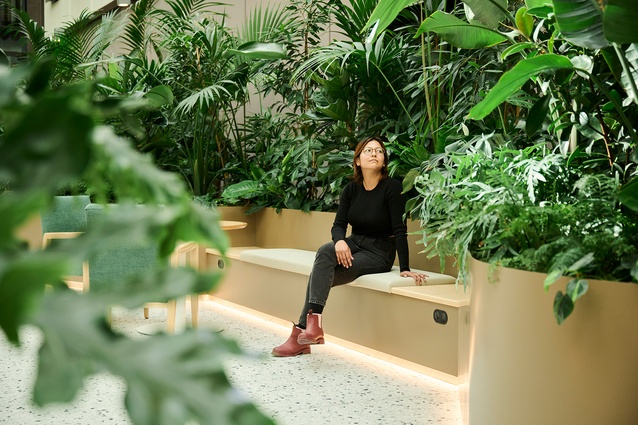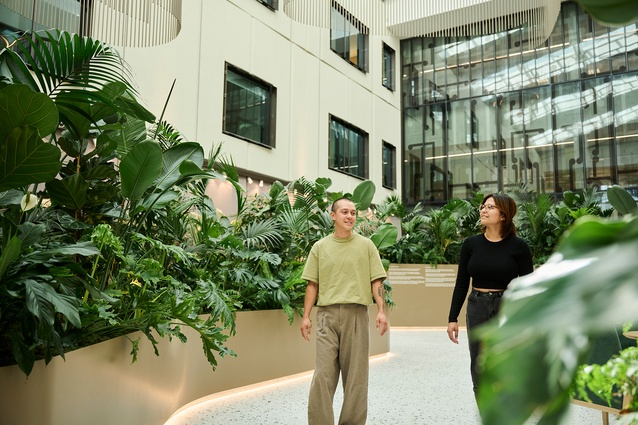Nature’s return to healthcare design
Healthcare environments are typically clinical and sterile — and necessarily so. However, the impact of their design on user wellbeing can be equally stark. During Mental Health Awareness Week, Ryan McQuerry of Outside In proposes we imagine the possibilities of healthcare interiors to leverage nature’s profound healing power.
International research has highlighted numerous benefits from bringing nature into healthcare designs.1 One well-known study2 by Roger Ulrich found that hospital patients with a view of trees, compared to those of a brick wall, achieved improved recovery outcomes, including:
- Shorter post-operative stays
- Less need for pain medication
- Fewer negative evaluative comments recorded in nurses’ notes
In a New Zealand first, the recently opened Tōtara Haumaru public hospital applies this research on scale. The four-storey building at Auckland’s North Shore Hospital features a large planted interior space, known as the Healing Garden, in its central atrium.
The design concept for the Healing Garden was developed by Jasmax in collaboration with Outside In, Haumi and the Well Foundation. Plantscaping by Outside In recreates a natural forest canopy within the indoor environment, with greenery flowing across more than 110 square metres.
Wellbeing benefits from biophilia
The concept of biophilia acknowledges our instinctive positive response to nature and natural elements. Incorporating greenery into the built form is one of the most common applications of biophilic design.
Research has demonstrated which biophilic principles are most valued in a hospital setting among different types of users:3
- Patients – this included prospect and refuge, security and protection, light and views of nature
- Outpatients – this included fresh air, light and a comfortable temperature
- Medical staff – this comprised privacy, refuge and quietness
Traditionally, incorporating greenery into healthcare projects has proved challenging, particularly in maintaining and growing the planting. However, simply weaving the shapes and colours of the natural world can offer benefits.
A one-of-a-kind New Zealand hospital garden
The Healing Garden is already gaining international interest for its transformative use of nature in a hospital, with Outside In winning a top award for its plantscape in the US-based global Biophilic Design Awards orchestrated by i-Plants Magazine.
Tōtara Haumaru provides a fully accessible visual and tangible connection to nature via the Healing Garden, with many patient recovery rooms enjoying views of the greenery. It is also overlooked from the hospital floors above.
The Ulrich study suggested beneficial views of nature consisted of a window looking out to a small cluster of trees but at Tōtara Haumaru, patients have an outlook onto more than 500 lush plants as well as direct access to them.
To balance proportions in the tall atrium space, planting reaches up to two metres tall, with 15 different species featured, including New Zealand natives. The Healing Garden’s form mimics that found in nature – it uses a purpose-designed product concept of ‘garden beds’ formed from powder-coated, timber-toned aluminium.
Enhancing staff well-being and performance
Alongside patient wellbeing, medical staff also significantly benefit when nature is prioritised. Studio Elsewhere’s ‘Recharge Rooms’ highlight the possibilities from simply engaging our senses. They applied music, smell, lighting, and sound to envelope users in an experience of the natural world.
Research conducted on the project concluded that a single 15-minute experience in a Recharge Room reduced self-reported stress levels among participants by an average 59.6 percent.4 Imagine what the result may have been if living plants were included?
Supporting staff wellbeing was one of the key priorities in the Healing Garden project and the medical team has their own private and secluded ‘pocket of nature’ where they can recharge during breaks in their work day.
While the Healing Garden was only recently opened, feedback from both staff and patients has already been very positive.
Delivering value for healthcare providers
Funding can prove a key issue when considering biophilic projects in the healthcare sector. This project realised a vision by the Well Foundation charity, to inspire the local community in creating a world-class public health facility and the entire project was donor funded.
A generous donation of over $100,000 by the clubs of Rotary District 9910 made a significant contribution towards the project’s realisation and is memorialised by way of printed placade on the planting beds that recognise the efforts of Rotary members alongside Well Foundation.
Outside In’s work shows how large-scale living planting can achieve stringent hospital requirements and optimise cost-effectiveness. The project achieved the waterproofing, fire rating, and weight loading necessary to protect operating facilities on the floor below.
Shorter hospital stays and supporting staff wellbeing are just two examples of how these projects can deliver a return on investment for hospital providers. Hospital gardens not only create a more pleasant environment that supports healing but they also create a resource for the wider community to enjoy and take pride in. Public areas effectively become spaces that engage the senses, encouraging people to feel at ease and connected to nature.
Conclusion
Prioritising nature in hospitals can advance patient outcomes and wellbeing for staff and patients alike, while also delivering value to healthcare providers. As the first of its kind for New Zealand, the Healing Garden demonstrates the psychological and physical benefits that can be achieved when we weave nature into healthcare design.
About the writer

Ryan McQuerry is co-founder and Creative Director of Outside In. Since the company’s founding in 2014, he’s played an integral role in its growth. Today, Outside In is New Zealand’s largest interior greenscaping business and the winner of prestigious international plantscaping and biophilic design awards.
Ryan’s career has revolved around horticulture and design. He is known for his innovative thinking to develop better ways of integrating nature into the built environment. Along with being a passionate advocate of biophilia, Ryan champions the benefits of integrating greenery into architecture — setting the standard for the greenscaping sector in New Zealand.
References
1 Nieberler-Walker K., Desha C., Bosman C., Roiko A., & Caldera S. (2023). Therapeutic Hospital Gardens: Literature Review and Working Definition. HERD: Health Environments Research & Design Journal, 16(4), 260-295. doi: 10.1177/19375867231187154
2 Ulrich, R. S., (1984). View through a Window May Influence Recovery from Surgery. Science, 224(4647), 420-421. doi:10.1126/science.6143402
3 Tekin B., Corcoran R., & Gutiérrez R. (2023). A Systematic Review and Conceptual Framework of Biophilic Design Parameters in Clinical Environments. HERD: Health Environments Research & Design Journal, 16(1), 233-250. doi:10.1177/19375867221118675
4 Putrino D., Ripp J., Herrera J., Cortes M., Kellner C., Rizk D., & Dams-O’Connor K. (2020). Multisensory, Nature-Inspired Recharge Rooms Yield Short-Term Reductions in Perceived Stress Among Frontline Healthcare Workers. Frontiers in Psychology, 11. doi: 10.3389/fpsyg.2020.560833

